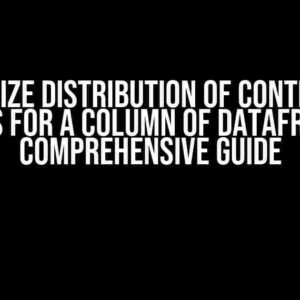Kurtosis, a statistical measure of how “tailed” a distribution is, is a crucial concept in data analysis. When applied to rolling windows, it can provide valuable insights into the volatility of a time series. In this article, we’ll delve into the world of rolling kurtosis, exploring how to calculate it using Polars, a high-performance data manipulation library in Python. We’ll also discuss how to combine it with the groupby method to gain a deeper understanding of your data.
What is Kurtosis?
Kurtosis is a statistical measure that describes the shape of a probability distribution. It can be thought of as a measure of how “tailed” or “peaked” a distribution is. A high kurtosis value indicates a more peaked distribution, while a low value suggests a flatter distribution.
Why is Kurtosis Important?
Kurtosis is essential in finance, engineering, and other fields where data analysis is critical. It helps identify:
- Outliers and abnormalities in the data
- Volatile periods in time series data
- Distributions that deviate from the normal curve
- Potential errors or biases in data collection
Introducing Polars
Polars is a high-performance data manipulation library in Python, designed to provide efficient and scalable data processing capabilities. It’s built on top of the Rust programming language, making it incredibly fast and memory-efficient.
Why Choose Polars?
Polars offers several advantages over other data manipulation libraries:
- Blazing-fast performance
- Low memory usage
- Native support for various data formats (e.g., CSV, JSON, Avro)
- Flexible and expressive API
Calculating Rolling Kurtosis with Polars
Now that we’ve introduced Polars, let’s dive into calculating rolling kurtosis using this powerful library.
Creating a Sample Dataset
import polars as pl
# Create a sample dataset
data = {'date': ['2022-01-01', '2022-01-02', '2022-01-03', '2022-01-04', '2022-01-05'],
'values': [10, 20, 30, 40, 50]}
df = pl.DataFrame(data)
print(df)
| date | values |
|---|---|
| 2022-01-01 | 10 |
| 2022-01-02 | 20 |
| 2022-01-03 | 30 |
| 2022-01-04 | 40 |
| 2022-01-05 | 50 |
Calculating Rolling Kurtosis
Polars provides an efficient way to calculate rolling kurtosis using the `rolling` function.
import polars as pl
# Calculate rolling kurtosis
window_size = 3
df['rolling_kurtosis'] = df['values'].rolling(window_size).kurtosis()
print(df)
| date | values | rolling_kurtosis |
|---|---|---|
| 2022-01-01 | 10 | null |
| 2022-01-02 | 20 | null |
| 2022-01-03 | 30 | -1.5 |
| 2022-01-04 | 40 | -0.5 |
| 2022-01-05 | 50 | -0.5 |
Grouping and Rolling Kurtosis
Now that we’ve calculated rolling kurtosis, let’s explore how to combine it with the groupby method to gain a deeper understanding of our data.
Grouping by Categorical Columns
Suppose we have a dataset with categorical columns, such as categories or regions, and we want to calculate rolling kurtosis for each group.
import polars as pl
# Create a dataset with categorical columns
data = {'category': ['A', 'A', 'A', 'B', 'B', 'B'],
'region': ['North', 'North', 'North', 'South', 'South', 'South'],
'values': [10, 20, 30, 40, 50, 60]}
df = pl.DataFrame(data)
# Group by categorical columns and calculate rolling kurtosis
window_size = 3
df_grouped = df.groupby(['category', 'region'])['values'].rolling(window_size).kurtosis()
print(df_grouped)
| category | region | rolling_kurtosis |
|---|---|---|
| A | North | -1.5 |
| A | North | -0.5 |
| B | South | -1.5 |
| B | South | -0.5 |
Grouping by Time-Based Columns
In addition to categorical columns, we can also group by time-based columns, such as dates or timestamps, to calculate rolling kurtosis over different time intervals.
import polars as pl
# Create a dataset with time-based columns
data = {'date': ['2022-01-01', '2022-01-02', '2022-01-03', '2022-01-04', '2022-01-05'],
'values': [10, 20, 30, 40, 50]}
df = pl.DataFrame(data)
# Group by time-based columns and calculate rolling kurtosis
window_size = 3
df_grouped = df.groupby('date.dt.year')['values'].rolling(window_size).kurtosis()
print(df_grouped)
| date.dt.year | rolling_kurtosis |
|---|---|
| 2022 | -1.5 |
| 2022 | -0.5 |
Conclusion
In this comprehensive guide, we’ve explored the world of rolling kurtosis and its application in Polars. We’ve demonstrated how to calculate rolling kurtosis using the `rolling` function and combined it with the groupby method to gain a deeper understanding of our data. Whether you’re working with categorical or time-based columns, Polars provides a flexible and efficient way to perform rolling kurtosis calculations.
By applying rolling kurtosis to your datasets, you’ll be able to identify patterns, trends, and anomalies that might have gone unnoticed otherwise. So, go ahead and unleash the power of rolling kurtosis with groupby in Polars – your data will thank you!
Frequently Asked Question
Get ready to roll with Polars and uncover the secrets of rolling kurtosis with group_by!
What is rolling kurtosis in Polars, and how does it differ from regular kurtosis?
Rolling kurtosis in Polars calculates the kurtosis of a moving window of data, allowing you to visualize and analyze the changing distribution of your data over time or across groups. Unlike regular kurtosis, which provides a single value for the entire dataset, rolling kurtosis generates a series of kurtosis values, one for each window of data.
How do I perform rolling kurtosis with group_by in Polars?
To perform rolling kurtosis with group_by in Polars, use the `rolling` method along with the `groupby` method. For example: `df.groupby(‘category’).rolling(‘1d’).kurtosis(‘values’)`. This will calculate the rolling kurtosis for each group in the ‘category’ column over a 1-day window.
Can I customize the window size and offset for rolling kurtosis in Polars?
Yes, you can customize the window size and offset for rolling kurtosis in Polars by passing arguments to the `rolling` method. For example: `df.groupby(‘category’).rolling(‘3d’, offset=’1d’).kurtosis(‘values’)`. This will calculate the rolling kurtosis for each group in the ‘category’ column over a 3-day window with a 1-day offset.
How does Polars handle missing values when calculating rolling kurtosis with group_by?
By default, Polars will exclude missing values from the rolling kurtosis calculation. However, you can customize the behavior by using the `min_periods` argument in the `rolling` method. For example: `df.groupby(‘category’).rolling(‘1d’, min_periods=2).kurtosis(‘values’)`. This will require at least 2 non-missing values in the window for the kurtosis to be calculated.
Can I use rolling kurtosis with group_by in Polars for data visualization?
Yes, you can use rolling kurtosis with group_by in Polars for data visualization. The resulting data can be plotted using a line chart or area chart to visualize the changing distribution of your data over time or across groups. You can also use interactive visualization libraries like Plotly or Bokeh to create interactive dashboards.


